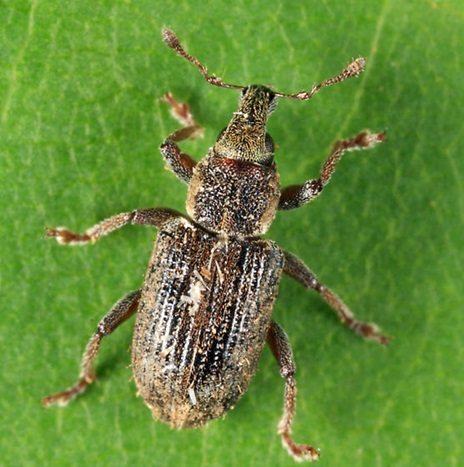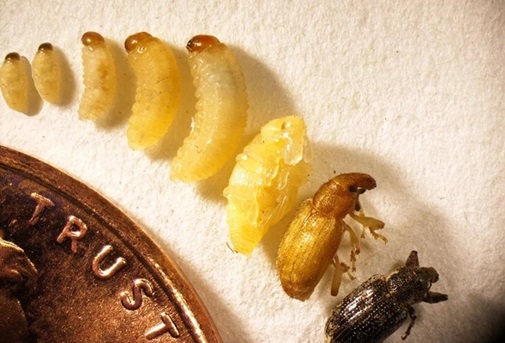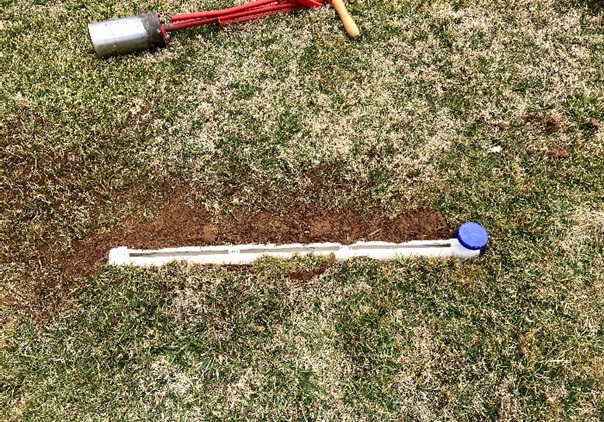Annual Bluegrass Weevil
ENTFACT-472: Annual Bluegrass Weevil - A Growing Concern for Kentucky Golf Courses | Download PDF
Kenneth Clayton, Extension Associate Senior and Jonathan L. Larson, Extension Entomologist
Fast Facts
- Annual bluegrass weevil (ABW) is a small (under 1/64th of an inch as an adult) pest of annual bluegrass and creeping bentgrass on golf courses. The larval stage is an internal and crown feeding pest that can cause extensive damage when unmanaged.
- Traditionally, this pest was a problem for golf courses in the mid-Atlantic and northeastern United States. In 2018, an infestation was found in Jefferson County Kentucky and since then it has been found in several other counties.
- Management of this pest is reliant upon early intervention and thorough monitoring. Scouting for adults can be done through the use of soap flushes in suspect areas, while soil cores extracted and run through a salt flush can help find larvae.
- If you believe you are dealing with ABW, please submit a sample or photograph to the authors for identification. After the submission, there might be follow-up site visit to collect specimens and confirm ABW. This helps to establish distribution in Kentucky.
Potential Hosts
Annual bluegrass weevil, also known as ABW, is pest primarily of annual bluegrass (Poa annua) though they will also readily feed on creeping bentgrass (Agrostis stolonifera). ABW is almost exclusively a pest of short-mown golf course turf. Damage caused by their feeding is usually found on golf tees, greens, approaches, collars, and fairways.
Symptoms and Pest Description
ABW is considered the most serious threat to golf course turf in the northeastern United States. When unmanaged, this pest is known to occur in high numbers and causes extensive patches of yellow and then dead turf. The larvae are the most damaging life stage, first by tunneling and feeding inside of turf plants and later feeding on the crown. Affected stands will appear patchy, with thin yellow areas mixed in with green, healthy turf. As generations accumulate and the turf becomes heat and drought stressed, damage becomes more apparent, with patches congealing into large brown dead areas. When pinched and pulled up on, affected turf will easily come out of the ground. Closer inspection of the turf may also reveal “sawdust” like fecal material. This “tug test” can help to narrow symptoms down to this pest over others such as white grubs. Further sampling with soapy water can obtain adults for confirmation.

Figure 1: Annual bluegrass weevil adults are small snout beetles with dark coloration. Photo by- Tom Murray, Bugguide.org.
Annual bluegrass weevil, like other weevils, has a snout that projects from the front of the face. They are considerably smaller than other weevil or billbug pests occasionally found in turf. For example, an adult bluegrass billbug is about 1/4th inch long while an ABW adult is only about 5/32nd inch long. It is easier to discuss in terms of millimeters, bluegrass billbug is about 8 mm long while ABW is 3-4 mm long. You can compare the adult ABW to the tip of a ballpoint pen. Adults are dark brown to black in color. Newly emerged adults will have yellow scales or flakes on their body. As they age, these are mostly rubbed off and the body will appear almost entirely black.
ABW eggs are rarely seen due to their size and oviposition location. They measure under 1 mm long and are laid by female weevils in the leaf sheath. Upon hatching, a grub-like like larva emerges to feed and will progress through five instars (stages) before pupating. Larvae are also small, ranging from 1/25th inch to 1/6th inch long or from 1 mm to 1.5 mm long. The similarity to white grubs comes from their coloration. ABW larvae are cream colored with reddish-orange head capsules and a “puffy” appearance. Unlike white grubs though, ABW larvae are legless.
Upon completion of larval development, they will pupate. Pupae are the same size as adults and the same color as larvae but lack the distinct red-orange head capsule.

Figure 2: Annual bluegrass weevil larvae are small, legless, cream colored, and have a reddish orange head capsule. Adult weevils are dark in color once their bodies have hardened. Photo by Ben McGraw, Penn State.
Annual Bluegrass Weevil Life Cycle
ABW overwinters as an adult weevil, using areas with debris that help to guard them from cold air temperature. They can be found in naturalized roughs, unmanaged areas, woods, landscaping, and rough edges. It is reported that they prefer to use areas of tall grass mixed with deciduous leaf litter over areas with pine needle accumulation.
In the spring, these overwintered adults will begin to emerge and find one another and mate, to start the first generation of the new year. In North Carolina and Virginia, the emerging adults start to pop up in late-February or early-March. In New York state, emergence begins around mid-April. Kentucky has been closer to the North Carolina emergence timing with adults being found in early-March in 2021 and 2022. Phenologically, peak overwintering adult emergence coincides with forsythia on or near the golf course appearing half green and half gold in the spring. Other plants to watch include eastern redbud and flowering dogwood being in full bloom. This is because the growing degree day (GDD) accumulation needed for overwintering adults to start to “wake up” happens to match with these plants. These timings were developed in the Northeastern US, there is hope that they will hold true here in Kentucky but our status as a climatic transitional zone may mean we will have to develop our own plant indicators.
After eggs have been laid in the leaf sheaths, they will hatch in April, though later hatching may occur due to colder climatic conditions. ABW has five larval instars, and each stage takes about a week to progress through. The first generation of larvae will usually complete development by the end of May or start of June. These new adults will then produce the second generation of larvae, sometimes with a compounding third generation as well. Scouting in Kentucky has revealed new adults appearing until late October and early November before they move away to overwintering locations.
The first generation of larvae is usually the densest in terms of population but may be easily missed unfortunately. Later generations become more obvious as their damage combines with earlier damage and the effects of summer heat/drought make symptoms more obvious.
ABW and Kentucky
Annual bluegrass weevil was first reported in Connecticut in 1931 and has been a major pest of golf turf in New England since the 1950s. It has slowly spread in the northeast over the last few decades before making jumps to Ohio and North Carolina in the early 2000s and then Arkansas, Kentucky, and Wisconsin between 2017-2020. In 2021, the first infestation in Indiana was discovered near the Evansville area.
Kentucky’s first reported and confirmed detection of ABW was on a golf course in Jefferson County, KY, near the city of Louisville, in 2018. Subsequently, confirmations were made in Bourbon, Kenton, Campbell, Franklin, Washington and Fayette County between 2019 and 2022. It is currently unknown exactly how the weevil was first introduced to Kentucky, though it is suspected that infested sod may have been brought to the state. The distribution of current known locations does not seem driven by the importation or movement of sod within the state of Kentucky though.
Management
ABW management hinges upon proper scouting and identification being followed up with thorough management. The highest degree of success may be obtained by frequently monitoring to know when and where to implement controls.
Scouting and Sampling
Managers can use multiple methods to monitor for ABW activity on their course.
- At first scouting can simply be doing a visual survey for damage. Injury to turfgrass may initially be observed along the edges of tees, fairways, collars, and approaches. Damage looks like declining turfgrass, yellowing, and dying out. Upon closer inspection or magnification, holes bored into the stems of the grass may be observed. On putting surfaces, damage may look like pitting of the grass and splotchy brown areas. If soil moisture is sufficient, disease is not present, and there are no indications of mechanical or herbicidal injury, ABW could be the cause. Another way to visually monitor is to inspect the clippings collected in baskets after mowing greens for the presence of adults.
- Soap flushes are an effective way to scout for annual bluegrass weevil adults. This method requires lemon scented dish soap and water. Mix 1oz of dish soap per gallon of water. Pour the solution slowly over a set area of grass (usually 1 sq. ft.) and soak the turf to runoff, Then, wait five minutes and apply the solution again. Continue counting the weevils while allowing the solution to saturate the soil. Following the second application, collect weevils for 15-20 minutes. Doing this over multiple spots in the same area gives you a stronger estimate of activity e.g. 5 different 1 sq. ft. patches on the same fairway.
- To monitor for overwintering adult emergence, linear pitfall traps can be installed near possible overwintering habitat to collect adults on the move. Pitfall traps can be made by taking a 2” pvc pipe and cutting to a length of 3’. Two separate linear slits approximately 0.25” wide should be cut nearly the length of the pipe leaving a small section connected in the middle. One side is then capped off and the other end placed into a catch container. Traps should be placed just slightly below the soil surface and sloped towards the catch container. The pitfall traps should be located between suspected overwintering sites and short mown grass like a fairway or putting green.
- Salt flushes can be used to extract larval stages of annual bluegrass weevil from a turf plug. To perform a salt flush mix 1lb of table salt per gallon of water. Extract a core or plug of turf from a suspect area and cut the dirt off the bottom, all you need is the thatch-soil interface. Break the core into smaller sections and then submerge the core in the salt solution and stir. After waiting 10-15 minutes, larvae, if present will begin floating to the top. A hand lens may help in seeing first and second instar larvae because they are so small.
Scientists have also used heat extraction and vacuum sampling to collect ABW from affected courses, though those methods may be more involved that managers would want to attempt.

Figure 3: When monitoring, if you look at damaged turf, you may see the small exit holes left behind when larvae leave the plant. Photo by Kenneth Clayton.

Figure 4: Linear pitfall traps constructed from PVC pipe, can help to monitor for the movement of overwintering adults in the spring. Photo by Kenneth Clayton.
Suppression Options
There are several chemical and biological controls available for use in the management of annual bluegrass weevil. As stated above monitoring your local site closely is important for optimally timing applications of chemical and biological controls. The best opportunity to mitigate damage from the annual bluegrass weevil is to target the overwintering adults in the spring and the larvae from the eggs of these adults. Peak adult activity can be determined by scouting frequently to track if adult presence is increasing each week or by using the aforementioned phenological indicators. Seeing annual bluegrass weevils mating is a sure sign that the area is under peak adult activity.
After a well-timed adulticide application, a single application of a larvicide may be all that is needed to prevent significant damage for the rest of the season. Use scouting techniques to determine when larvae are present and if possible, allow minimum amounts of turf injury to be observed on Poa annua before making treatments. It is essential to know that only a few stages of larvae are easily controlled. Eggs and pupae cannot be chemically controlled. Larvae that are within the stem are very difficult to control. The best time to control larvae is when the majority are out of the stem and in the soil. Larvicides are most effective at larval stages 3-5.
Following these two applications it is possible that there will be no further need for insecticide use, or they may only be needed for isolated areas. Even though Kentucky will have approximately three generations of annual bluegrass weevils, if adequate control is accomplished in the spring, future generations should not surpass the damaging threshold level. As the season progresses, the timing of applications can be difficult because of the asynchronous life stages of the annual bluegrass weevil. Due to the prolonged egg laying period of females during the summer all stages of the weevil may be found at one time in the same area. Following spring applications further chemical controls should focus exclusively on larvicides. Please refer to the chemical chart for available products and applicable life stages. If choosing to treat, be sure to rotate between the listed classes when spraying multiple times in the same season.
Table 1: Insecticides from several classes may be used in a management program for annual bluegrass weevil. The labelled products displayed here are arranged by IRAC number and their use as an adulticide or larvicide and are not ranked by efficacy.
Table 1 continued: Insecticides from several classes may be used in a management program for annual bluegrass weevil. The labelled products displayed here are arranged by IRAC number and their use as an adulticide or larvicide.
Table 2: Combination products are also labelled for annual bluegrass weevil management. These insecticides contain two different classes of chemistry and may provide both larvicidal and adulticidal control or may help with resistant populations.
Table 3: There are also bioinsecticide options labelled for annual bluegrass weevil management.
02/23 (Issued)
CAUTION! Pesticide recommendations in this publication are registered for use in Kentucky, USA ONLY! The use of some products may not be legal in your state or country. Please check with your local county agent or regulatory official before using any pesticide mentioned in this publication. Of course, ALWAYS READ AND FOLLOW LABEL DIRECTIONS FOR SAFE USE OF ANY PESTICIDE!
Images: University of Kentucky Entomology unless otherwise indicated




